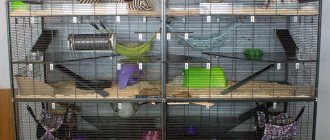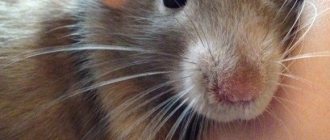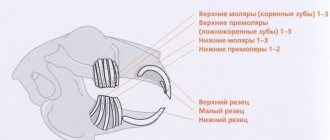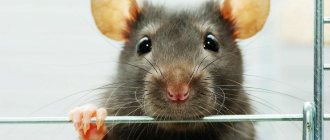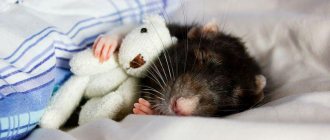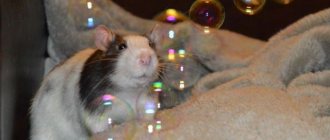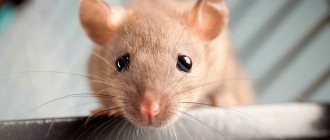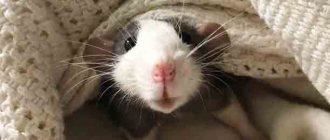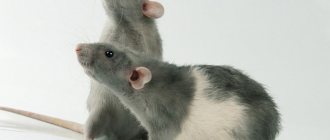- home
- Rat
- Care
07/10/2019 Rat teeth are amazingly sharp and hard. The jaws of a small rodent easily create a pressure of over 1.5 tons per 1 cm². Such jaw power allows the animal to easily bite through lead pipes and steel wire, chew cinder blocks, etc. This article will discuss the characteristics of the teeth of the animal, which is gaining popularity as a pet, as well as the prevention of dental diseases in rodents.
Anatomical features
In most mammals, the chewing surface is arranged in a certain way. Their dentition consists of the following types of teeth:
- incisors;
- molars (or molars);
- premolars;
- fangs.
Unlike most mammals, rats have a more specific jaw structure. The dentition of these rodents includes only two types of teeth out of four possible, these are:
- incisors (only the front ones, these animals have no second ones);
- molars.
The places in the row provided for other types of teeth are empty in rats. Thus, in the dentition of rats there are gaps called diastemas.
Skeleton
Despite its lightness, the skeleton is strong, mobile and elastic.
The skull and its facial part are elongated; the joints of the bones are well developed on the skull. It contains paired coronoid, frontal, parietotemporal, lamboid, interparietal bones and unpaired occipital bones.
The lower jaw can move in three directions: across, along and up.
Like all mammals, the mouse spine is divided into five sections and includes:
- cervical – 7 vertebrae,
- thoracic – 13 vertebrae,
- lumbar – 7 vertebrae,
- sacral – 4 vertebrae, two of which are fused,
- caudal - the number of vertebrae can reach 20.
The sternum is narrow and consists of 13 paired ribs. Some species of mice do not have collarbones, which gives them the ability to crawl through tiny holes.
How many teeth does a rat have
As for the number of teeth in rats, the little animal has 16 of them:
- 4 incisors;
- 12 molars (molars).
On the upper and lower jaws, the arrangement of teeth is the same - according to the 3-2-3 pattern. In the center (i.e., in front) of each jaw there is a pair of incisors, which are surrounded at a distance on both sides by triplets of molars.
Types of decorative rats
There are several varieties of the Dumbo breed:
Siamese
The color of the Siamese is similar to that of the cat breed of the same name: white or light beige fur and a small brown spot on the face.
The color of the husky is similar to the color of the coat of the dog breed of the same name: white coat with dark spots on the body and head.
The Rex's long curly coat, hairs and whiskers are slightly curled.
Sphinx
There is no wool. The skin is thin, soft and warm. The main advantage of the species is its inability to cause allergies.
A cage with metal bars is needed so that the animal cannot chew them. It must be installed in a place that is not in a draft, in direct sun, near a radiator or heater. The cage size for 1-2 rats is at least 60x40x30 cm.
The room temperature should not fall below +20 degrees, otherwise there is a high probability of your pet catching a cold.
The cage contains attributes for entertainment and sleep: a house, a wheel, pipes, ladders.
Large sawdust or dry granules are suitable as filler.
You cannot put newspaper paper in a cage.
When wet, it emits toxic substances contained in printing ink, which causes great damage to the health of the animal.
The filler is changed every 2-3 days. Once every 15-17 days, all elements of the house are treated with a disinfectant.
Dry air can harm your pet's health, so the humidity in the room should be 50-55%.
Dumbos are friendly and easy to get along with if treated affectionately. It is forbidden to talk loudly near the animal, shout at it, hit it, push it hard, sharply grab it or pick it up.
When the cage is heavily soiled, Dumbo rats can squeak loudly; when there is a lack of food, they can rattle the feeder or stand on their hind legs next to it.
To grind down teeth, rats are provided with wooden sticks made from hardwood.
Dumbos are distinguished by their friendliness and easy-going nature, so they easily get along with other animals. The main problem becomes the character of the rat's neighbor.
These animals do not like to sit in a cage all the time, so they need to be walked around the house. The owner needs to be careful: there is a risk of not noticing the pet and stepping on it. In addition, your pet may chew on wires.
Bathing is often prohibited, only in cases of extreme necessity. These animals are susceptible to colds. In case of local contamination, you can remove the dirt with a damp cloth.
Features of incisors
Thanks to their strength, the animals chew through not only wood, bricks and concrete, but even metal. Incisors appear in rat pups a week after birth. Their growth process is accelerated - up to 2-3 mm per week. They reach their usual length by the age of two months. But their growth not only does not stop there, but also does not slow down.
The constant growth of incisors requires regular grinding. Excess length causes many problems, including the death of the animal.
They are covered with enamel only on the front. The back surface is covered with a soft, fast-wearing substance called dentin. This heterogeneous coating determines the sharpness of the incisors.
Feeding
These pets are quite unpretentious in their choice of food, but are not omnivorous, like ordinary ones. Decorative rats are very gentle creatures, often having intestinal problems and allergies. Its menu should include:
- grain base - it is better to purchase a special mixture for rodents in pet stores. It should make up 60% of the total diet. You can also feed with unprocessed pumpkin, flax or sunflower seeds;
- proteins - occasionally (1-2 times a week) give a little meat (raw or boiled), chicken, yogurt, cottage cheese, eggs will benefit your pet;
- herbs - parsley, cilantro, dandelion, dill, plantain, radish tops;
- vegetables and fruits (preferably boiled) - apples, bananas, carrots, white cabbage, cucumbers, tomatoes, pumpkin, eggplant, potatoes. Citrus fruits must be treated selectively - they can cause allergies in your pet;
- delicacies - grain sticks, nuts, dates, berries, dried fruits, raisins, crackers (unsalted only), unsweetened cookies, boiled pasta, boiled shrimp and seafood.
It is necessary to give fish oil and specialized vitamins. Animals are fed 2 times a day: morning and evening. The exception is pregnant rats - they are fed 4-5 times a day. If you adhere to the basic requirements for what to feed your rat Dumbo, he will be healthy and cheerful.
Important! If your pet refuses to eat for 1-2 days, you should immediately show him to a veterinarian!
These pets are quite unpretentious in their choice of food, but are not omnivorous, like ordinary ones. Decorative rats are very gentle creatures, often having problems with the intestines and allergies.
Its menu should include:
- grain base - it is better to purchase a special mixture for rodents in pet stores. It should make up 60% of the total diet. You can also feed with unprocessed pumpkin, flax or sunflower seeds;
- proteins - occasionally (1-2 times a week) give a little meat (raw or boiled), chicken, yogurt, cottage cheese, eggs will benefit your pet;
- herbs - parsley, cilantro, dandelion, dill, plantain, radish tops;
- vegetables and fruits (preferably boiled) - apples, bananas, carrots, white cabbage, cucumbers, tomatoes, pumpkin, eggplant, potatoes. Citrus fruits must be treated selectively - they can cause allergies in your pet;
- delicacies - grain sticks, nuts, dates, berries, dried fruits, raisins, crackers (unsalted only), unsweetened cookies, boiled pasta, boiled shrimp and seafood.
It is necessary to give fish oil and specialized vitamins. Animals are fed 2 times a day: morning and evening. The exception is pregnant rats - they are fed 4-5 times a day. If you adhere to the basic requirements for what to feed your rat Dumbo, he will be healthy and cheerful.
If the owner is interested in his pet living as long and healthy as possible, the following products should be avoided:
- chocolate and products containing it;
- other sweets;
- sausage and frankfurters;
- canned food for people;
- raw beans and other legumes;
- cheeses (especially blue and salted);
- soda;
- sprouted potatoes;
- Brussels sprouts and red cabbage;
- green bananas;
- spinach;
- beet;
- fatty and salty foods.
Home care
To prevent dental disease in your animal, it is important to properly care for your pet. Caring for a rat's incisors involves providing the animal with hard materials for grinding. These are special items that an animal can chew with benefit for its teeth:
- toys;
- bars, etc.
If the rodent does not have access to such materials, it may begin to grind down the incisors on its own. At the same time, the animal makes a sound with its jaws, similar to tapping.
If the continuously growing incisors are not ground down in time, this will lead to their curvature, bending and other deformations that cause suffering to the animal.
Individuals with malocclusion need special precautionary care. They are not able to properly grind off excess length, so the responsibility for shortening lies with the owner of such an animal.
You can help the animal by cutting the enamel. Don’t be afraid to trim your rat’s teeth - this procedure does not take much time and, moreover, it is painless for the animal (the enamel is not connected to the nerve endings). The enamel only needs to be trimmed a few millimeters.
General characteristics of the animal
Depending on the species, the length of a rat’s body can range from 8 to 30 cm. A distinctive feature is a long tail, sometimes exceeding the length of the body. The weight of the animal ranges from 37-400 g. Particularly large individuals of gray rats can reach a weight of 0.5 kg.
Classic shades of wool are gray and brown, although yellow and orange colors are also found. The main types of wild rats are gray and black, widespread everywhere. The rest of the rodents live in a strictly defined area.
The following breeds are best suited for home keeping:
- standard - large animals with a long tail and smooth fur;
- satin - the animals are covered with a thin six, curling blue;
- Dumbo - funny animals with a wide head, pear-shaped body and large round ears;
- Sphynx - hairless rats with pink shiny fur;
- tailless - a distinctive feature is the complete absence of a tail.
The structure of molars
Molars are wide and flat in shape. Interestingly, rats do not chew, but grind food using molars. When an animal eats, its jaws do not move up and down, but back and forth. Moreover, only one of the jaws moves. Thus, the food does not crumble, but is ground, after which the animal swallows it.
For better grinding of food, ridges and tubercles are provided on the molars. Enamel covers only the sides of the molars - the middle has a dentin coating. It is worth noting that the enamel is very durable - its hardness coefficient is 5.5 (for comparison, for diamond it is 10).
Molars in baby rats erupt alternately from near to far:
- on the 19th day of birth - the first two pairs;
- on the 21st day - the second batch;
- by 4–5 weeks – the third ones complete the dentition.
A six-week-old rodent already has a full set of teeth. Molars grow until the animal is 4 months old, then growth gradually stops.
Disease Prevention
To help your pet stay healthy and alert, you need to monitor the condition of his jaws and teeth. Owners should be alert to the following dangerous symptoms:
- wounds on the mucous membranes of the cheeks and lips;
- knocking sound that appears when eating;
- increased salivation;
- loss of appetite;
- swelling of the tongue or mucous membrane;
- abscess formation.
In each of these cases, it is necessary to contact a specialist in time. The veterinary clinic usually conducts an examination, testing for bacterial microflora, and treating the oral cavity with local antiseptics. Also, if necessary, the doctor can trim or grind the incisors, correct the bite and give recommendations on proper care.
The assortment of pet stores will also help you deal with all possible problems in a timely manner.
A ratologist is responsible for the health of rats. For questions regarding maintenance, treatment and other assistance, please contact tel. +7 (495) 669-31-09 (Moscow); (Saint Petersburg)
Ratologists work around the clock:
| Services | Prices |
| Ratologist is on call from 9.00 to 21.00 | 600rub |
| Ratologist is on call from 21.00 to 9.00 | 1200rub |
| Initial examination of the rat | from 500r |
| Cost of a doctor's consultation visit | up to 2000r |
| Average cost of a visit to provide medical care | from 2000 rub. up to 4000 rub. |
| Average cost of surgical procedures | 3000rub |
Please note that a ratologist’s visit consists of a Doctor’s Call, an Examination of the animal and Additional therapeutic measures.
Source
Mineral composition
A rat's teeth are made up of three layers:
- pulp;
- dentin;
- enamel.
Pulp is the soft core. This is a concentration of nerve canals and blood vessels. The pulp is surrounded by a harder layer of dentin. Its thickness exceeds the layers of pulp and enamel combined.
The outer coating – enamel – is the hardest and most durable. The enamel crown contains mineral components, the main one being calcium.
Why do rats have yellow teeth?
Thanks to the vertical groove under the rodent's nose, its upper incisors are constantly visible, even when the animal's mouth is closed. Because of this feature, it is clearly visible that the rat has yellow teeth.
Initially, the rodent's incisors are white, but by the 21st day of life, the upper ones acquire a yellow tint. By the 25th day, the upper incisors are already completely covered with yellow pigment, and the lower ones are just beginning to turn yellow.
By the 38th day, the lower ones acquire a rich yellow color, but the upper ones by that time become even more pigmented. Rat teeth retain this difference in the density and richness of the yellow color throughout the animal’s life. In adults, the upper incisors are a rich dark red color, while the lower ones are still colored yellow.
Gambian rats find landmines and detect tuberculosis
- Early sleep studies involved tireless researchers forcing rats to wake up to see the effects. At that time, people didn't know what the role of sleep was, but they didn't think that lack of sleep could kill you. During the experiment, the rats who were not allowed to sleep constantly deteriorated in health, as well as in their emotional state. They became aggressive and disoriented, lost their hair, developed sores on their legs and tails, ate more but lost weight, and eventually their internal organs failed completely. After 17-20 days of sleep deprivation, they finally received the sweet grace of death.
- A more humane study found that rats laugh, or at least make a sound that sounds like laughter. The rats studied made these sounds (undetectable to the human ear) when they were tickled.
- Mice and rats were not always considered two different creatures. Of course, the Romans didn't consider this, calling them Rattus Major (big rat) and Rattus Minor (little rat) instead.
- At least 4 genetically unique strains of hairless rats exist in laboratory settings, as well as in the pet trade. In the pet trade they are often called Sphynxes.
- Rats use their whiskers to sense where they are going because their vision is too weak to be of any help. This is why you will rarely see it outdoors where its whiskers do not touch some kind of boundary. This will make them vulnerable to hawks and other predators.
- People have used rats as laboratory assistants, companions, religious icons, and characters in popular fables. They even took on the job of feeding desperate poor people meat, searching for potentially live mines, and some were even trained as electricians to pull wire through walls.
- Legend has it that the rat is supposed to be the first animal of the Chinese zodiac.
- Rats cannot sweat and they do not vomit. Most rats use their tail to get rid of excess heat. Tailless rats don't have that luxury, so if you have one, keep them alone!
- Queen Victoria's Royal Pied Piper gave an albino rat to Beatrix Potter, author of the much-loved Peter Rabbit series. She was one of the first owners of such animals and even mentioned this beloved pet in at least one of her stories.
If you have an interesting or unusual fact about rats, tell us in the comments!
